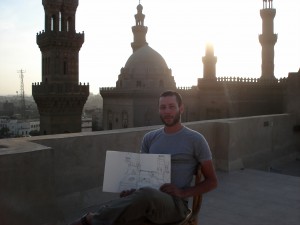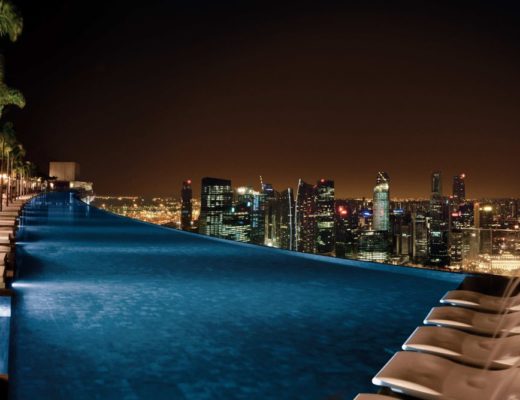Australian artist Damon Kowarsky talks to Ruby TV from Cairo where he has returned for his latest exhibition ‘In Visible Cities’.
Tell me about the exhibition in Cairo.
The exhibition in Cairo is at Mashrabia Gallery, one of the oldest established commercial galleries in the Downtown area of Cairo. Together with Townhouse and Atelier it forms part of the dynamic art scene of the city.
The title ‘In Visible Cities’ comes from Italo Calvino’s book of [almost] the same name. This book talks about the different ways a city – in Calvino’s case Venice – can be seen by the people who inhabit it.
With my interest in urban spaces it seemed an appropriate subject matter. ‘Invisible Cities’ is also the theme of a literature festival in Cairo organised by the gallery director Stefania Angaro.
This is my first solo exhibition in Egypt, and comes after many years of living, working, and visiting the city. I will be very curious to see what Egyptians make of my interpretations of their famous, complicated, beautiful and sometimes disturbing city.
Are you in Cairo now? How has it changed (or not) that you have remarked? What is your view on the January events and how things are now?
Yes, I arrived here on the 6th of May. Physically there are not so many changes [any damage from the protests in January was cleaned up very quickly] though the absence of the government’s hand in everything has meant that there is a different spirit to the place. Street stalls abound selling everything from protest t-shirts to plastic tanks. Below Townhouse Gallery a vacant window has turned into a thriving sandwich shop. It is good to see such entrepreneurship.
The big changes seem to be in the people. While there are still worries for the future, people I speak to talk of a new feeling of freedom and openness. The dreaded State Security service has disappeared, it is possible to openly criticise political leaders, and there is the powerful knowledge that this revolution was made by the people themselves.
Even with the uncertainties and economic downturn from the collapse of tourism it is a very exciting time to be here.
I was in Australia when the 25 January Revolution began. Naturally I was worried for my friends, many of whom quickly got involved in the demonstrations. At the time I remember wondering how hard the government might crack down to re-establish control. As it happened, and despite the deaths of many protestors, things went surprisingly smoothly. Certainly very different from the situation in Libya and Yemen.
Perhaps part of this was the good relations between Egypt and its army. Perhaps another was fatigue on the part of the ruling forces. Perhaps the greatest factor was that my friends said they had lost their fear, and so could no longer be controlled by a government they disagreed with.
How has your work transformed over the past year or two? What are you now focusing on?
Following my travels around the world in 2009 I have become much more interested in modern cities and the complicated life they contain. I have also started looking at the presence of military force in contemporary life – whether that be tanks rolling through Tahrir Square in January or Blackhawk helicopters doing training manoeuvres above Melbourne in March.
At the same time I am making a series of much more personal portraits of friends and colleagues. I find it important to work all the way along the spectrum. The world is complicated, and neither war nor love alone gives anything near the complete picture.
Current inspirations?
Weapons, plants, buildings, cars, planes and airports, friends, life models, cultural artefacts, contemporary cinema, and the amazing natural history collection of the Melbourne Museum.
What are you plans for the rest of 2011?
A collaborative exhibition with the Japanese artist Kyoko Imazu at Port Jackson Press in June, group shows in Melbourne in July and September and the possibility of another solo show later in the year at Joshua McClelland Print Room.
On May 14 I will teach a zine making workshop at Townhouse with the Egyptian writer and journalist Nancy Ibrahim. I am also talking to Darat al Funun in Jordan about teaching printmaking there at the end of this month.
In September Kyoko and I travel to Japan to install our work in the new Aesop store in Aoyama, and research ideas for our 2012 exhibition at the Japanese Consulate Melbourne.
It is a busy time, though very exciting and rewarding also. I will be sure to let you know how it all turns out!
In Visible Cities
etchings and drawings by Damon Kowarsky
8 May to 2 June, 2011
Official opening Sunday 8 May at 7pm by HE Ms Stephanie Shwabsky, Australian Ambassador to Egypt.
Mashrabia Gallery of Contemporary Art
8 Champollion St
Downtown – Cairo
Egypt
Open daily except Friday 11am to 8pm
More information and a map can be found at here.
Ruby’s article in Qantas in-flight magazine featuring Damon who gives a guide to Cairo can be read here.


